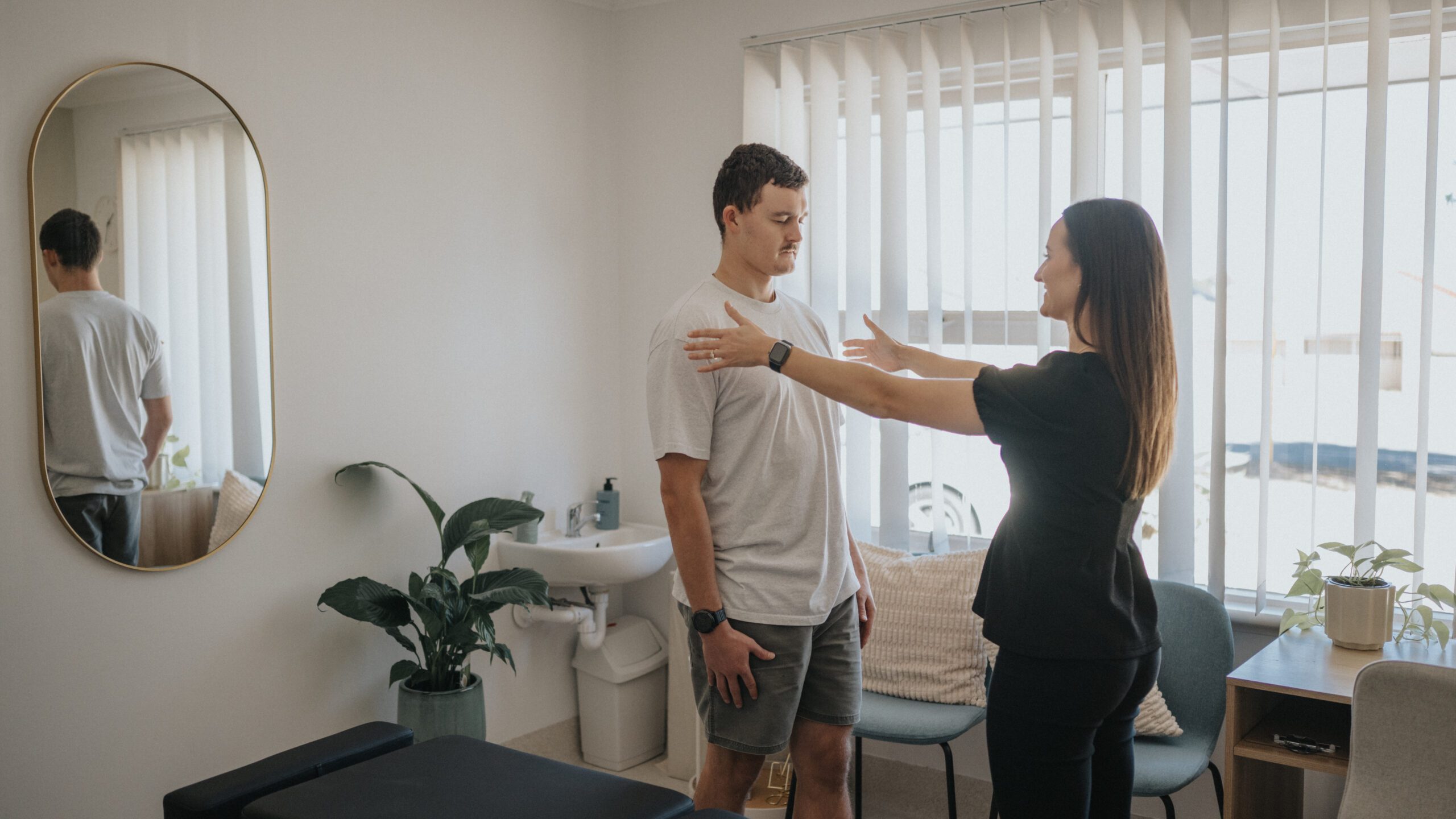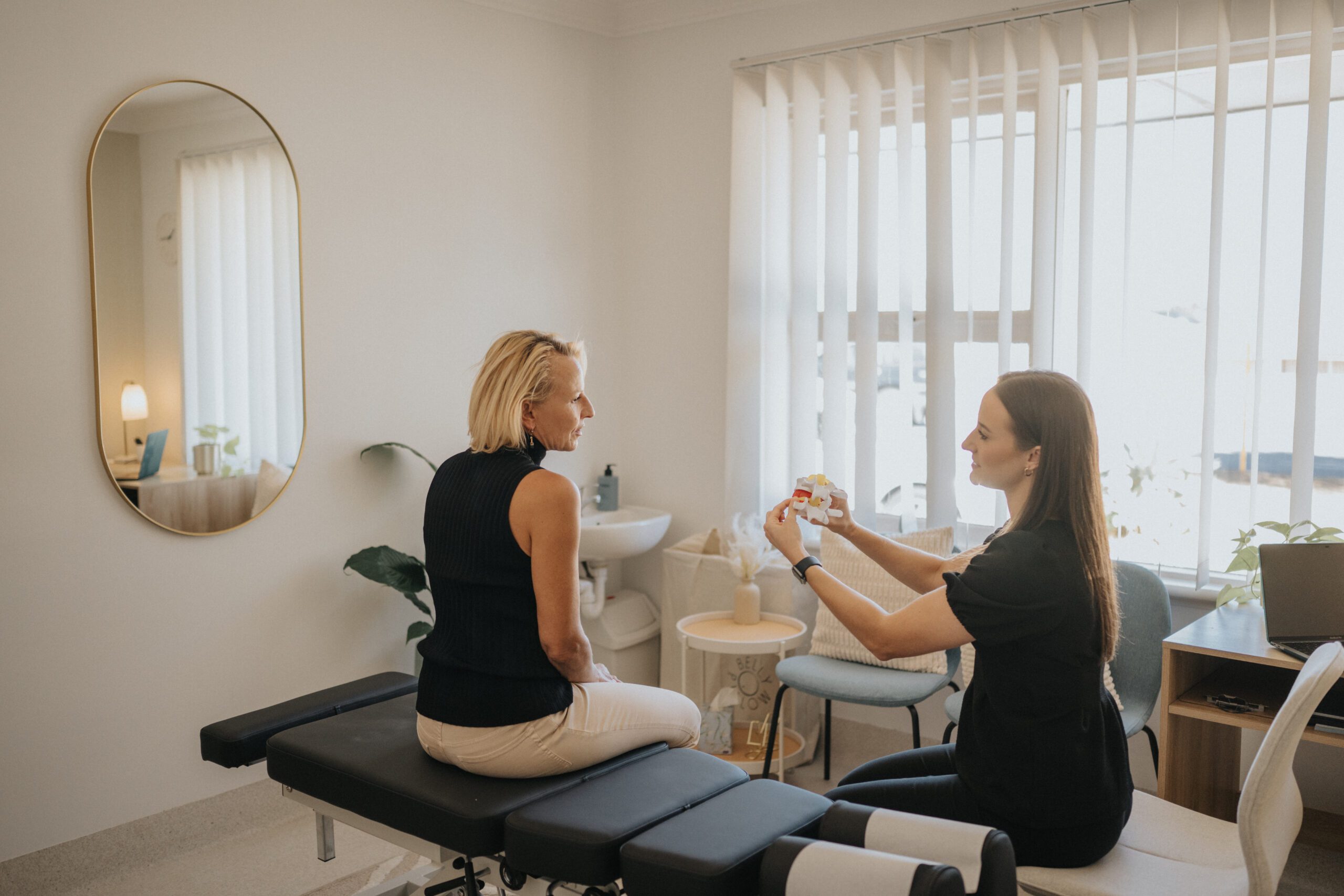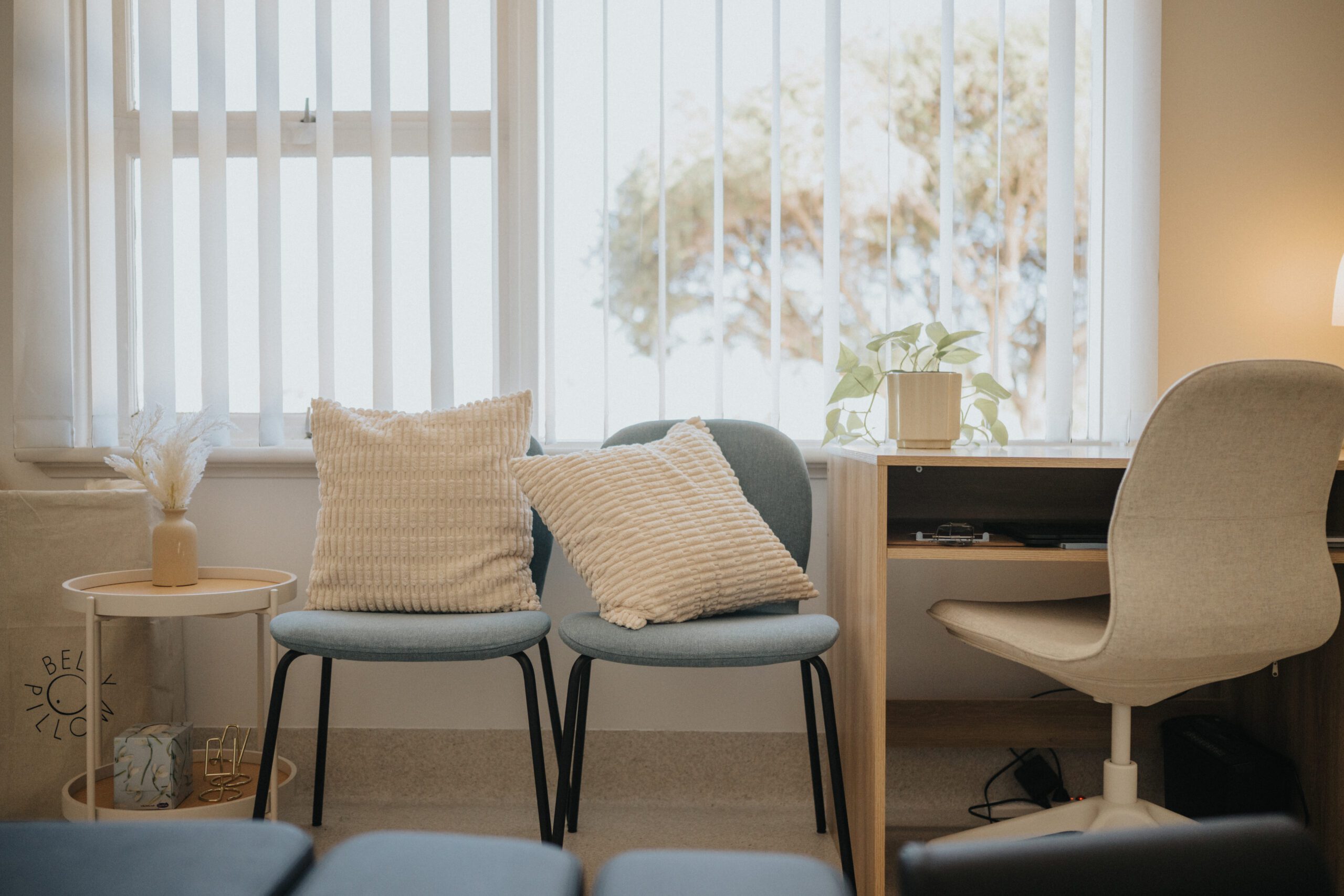Blog

Understanding Frozen Shoulder – Everything you Need to Know
Frozen shoulder, also known as adhesive capsulitis, is a condition that can significantly limit your shoulder’s mobility and cause pain and discomfort. If you’re struggling

Understanding Jaw Pain: Causes, Symptoms, and Treatment Options
Understanding Jaw Pain Jaw pain, often stemming from Temporomandibular Joint (TMJ) dysfunction, affects millions globally and can significantly impact quality of life. If you’ve experienced

The Ultimate Guide to Office and Home Work Ergonomics
The Ultimate Guide to Office and Home Work Ergonomics What you should be doing to get the most out of your office set up… In

Is There Such Thing as the Perfect Posture?
Is there really a one-size-fits-all position that solves all our aches and pains? What we have been told over and over again about posture is

Breaking the Cycle: Overcoming Chronic Low Back Pain
Living with chronic pain, especially low back pain, can feel like carrying an invisible weight everywhere you go. It affects more than just your physical

The 21st Century Headache
A world without headaches – is that even possible in our new age digital sedentary world? The modern era, where screens are apart of our

Breaking the Cycle: Overcoming Chronic Low Back Pain
A guide to confidently manage your pain for good!
Living with chronic pain is like hosting an unwelcome guest—it’s there whether you like it or not. Whether it’s low back pain, arthritis, or migraines, chronic pain can turn daily tasks into daunting challenges. Picture waking up every day with that dull ache in your lower back, a constant reminder of your body’s struggle. From tying your shoes to lifting groceries, every movement seems like navigating a minefield, with the risk of triggering discomfort and frustration. But it’s not just physical—chronic pain takes a toll on mental well-being too. It’s the worry, the fear of falling behind, the frustration of feeling limited. Yet, with the right support and strategies, there’s hope.
Living with chronic low back pain can feel like trying to solve a Rubik’s cube blindfolded—frustrating and seemingly impossible. You may think you have tried anything and everything but there is always another option
Chiropractic Care: Adjusting Your Perspective
Chiropractic adjustments are like a reset button for your spine and body, restoring balance to your brain – body connection and allowing your joints to move optimally. Chiropractic adjustments offer both short-term relief and long-term benefits, where each adjustment is tailored to what your body needs and what will get you the best results.
Rehabilitation: Building Strength for a Pain-Free Future
As chiropractors, our aim is not only to provide immediate relief from discomfort but also to empower our patients to take control of their health for the long term. One of the most effective ways to achieve this is through a focus on building strength and stability. Strengthening exercises serve as a crucial component of comprehensive care, consolidating the work we do during chiropractic adjustments, reducing pain and ensuring lasting results for our patients.
More solutions:
Identifying Key Stress Points:
Chronic pain often goes hand in hand with stress, creating a vicious cycle where pain exacerbates stress, and stress, in turn, worsens pain. Sometimes chronic pain is just as much about our mental state as it is our physical.
Awareness encourages us to become more aware of our thoughts, emotions, and bodily sensations, allowing them to identify specific stressors that may contribute to the experience of chronic pain. By paying attention to patterns of stress in daily life, you may be able to pinpoint triggers such as work deadlines, relationship conflicts, or financial worries that may exacerbate pain.
Here are some mindfulness approaches individuals can use to manage stress and promote relaxation:
Mindful Breathing: Taking a few moments to focus on the breath can help individuals ground themselves in the present moment and alleviate stress. By practicing deep, diaphragmatic breathing, individuals can activate the body’s relaxation response, reducing tension and promoting a sense of calm
Body Scan Meditation: Body scan meditation involves systematically directing attention to different parts of the body, noticing any areas of tension or discomfort, and consciously releasing that tension. This practice can help individuals become more attuned to bodily sensations and respond to signs of stress before they escalate into pain flare-ups.
Mindful Movement: Engaging in gentle movement practices such as yoga can help release physical tension and quiet the mind. By moving mindfully and paying attention to the sensations in the body, individuals can promote relaxation and reduce stress levels, thereby mitigating triggers for chronic pain.
Move More, Sit Less
Sitting or being in one position for long periods can be a real pain in the back, quite literally! So, make it a point to get up and move throughout the day. Take short walks, stretch at your desk, or try standing while working. Finding a balance between movement and rest is key to keeping low back pain at bay.
TIP: Set a timer for every 90 minutes at work – this can be a reminder for you to get up and take a break, get a drink of water or shuffle from a sitting to standing position!
Catch some Zzz’s
In bed is where your body does all the heavy lifting in terms of recovery, it’s spoken about so frequently for a reason! Prioritise good sleep hygiene by creating a comfortable sleep environment (cool and dark room), sticking to a consistent sleep schedule (regular sleep and wake times) and limit tech time before bed (big tick for phones out of the bedroom). Little changes will make a big difference to how we wake up the next morning!
There are lots of ways you can tackle chronic pain, you can choose to do it solo but sometimes it can be nice to have someone guide you in the right direction. Taking control now can allow you to have a pain free present and a better performance driven future.

Is There Such Thing as the Perfect Posture?
Is there really a one-size-fits-all position that solves all our aches and pains? What we have been told over and over again about posture is not as straightforward as it seems.
The perfect posture doesn’t exist, but we’ve all heard the advice to stand up straight and stop slouching. While we’ve been told since forever that there’s a perfect posture, recent evidence suggests otherwise. What constitutes an optimal posture remains debatable, with no agreement on the one correct posture. Any posture, if held for too long, could lead to pain and discomfort (Chen et al, 2021), yet we’re still fixated on finding the ideal one.
Variety in Postures: A Natural Phenomenon
Differences in postures are natural – our spines naturally curve and bend differently. Moreover, our posture can reflect our mood, thoughts, and emotions, and some postures might be our body’s way of protecting itself from further harm. Hence, aiming for a universally perfect posture might not be realistic or attainable for everyone.
It’s More About Movement than Perfect Posture
While there may not be a perfect posture, staying in one position for too long can contribute to our pain experience. So, rather than obsessing over the perfect posture, let’s shift the focus to movement.
People with chronic pain, especially those with low back pain, often have altered muscle activation patterns, leading to stiffness and postural instability. Improving these patterns and becoming more aware of our posture can lead to pain relief and prevent further discomfort.
Tips for Improving Posture
How can you improve your posture? Here are some tips:
- Task Substitution: Switch between different tasks that engage different parts of your body.
- Task Interruption: Take regular breaks to stretch or perform other activities.
- Increase Incidental Exercise: Incorporate more movement into your daily routine, like parking further from work or taking the stairs.
- Postural Awareness: Pay attention to what your body likes and dislikes, and find positions that are comfortable for you.
Key Takeaways
- There’s no single “good posture.”
- Prolonged periods in one position can lead to pain.
- Varying and adopting different postures regularly is beneficial.
Remember, it’s not about achieving the perfect posture, but rather about staying mindful of our bodies and keeping them moving.

The 21st Century Headache
A world without headaches - is that even possible in our new age digital sedentary world?
The modern era, where screens are apart of our daily routines. You’re not alone if you find yourself rubbing your temples after a long day of scrolling through your phone, binging your favourite show or working tirelessly at your desk. Our constant exposure to screens, be it phones, tablets, or computers, can wreak havoc on our heads.
The Sedentary Strain: How Sitting Affects Us
You’re at your desk, buried under a mountain of work, hunched over your keyboard for hours on end. While your dedication is commendable, your posture might be another story altogether. It is estimated that adults are sedentary for approximately 8 hours each day – with this time only increasing for those who take longer commutes, watch television or have desk jobs.
See, our bodies aren’t designed to sit for hours on end, yet that’s precisely what many of us do day in and day out, it is the nature of the modern work world for most of us.
When we slouch and slump at our desks, we’re not just inviting back pain—we’re also setting the stage for headaches to come knocking at our door. It is this stillness that does us a disservice, our bodies are made to move and we aren’t getting it enough.
Simply, most of us want to be active and want to be healthy, yet the place we spend most of our time – the workplace – is generally the least likely place to benefit our health. We are now realising that small movement, even something as simple of alternating between sitting and standing can actually make a difference to the way we feel, move, stay more alert, feel less fatigued and allow us to take steps towards our health goals.
Battling Digital Eye Strain
Eyes glued to the screen, scrolling endlessly through social media feeds or typing away furiously on our keyboards, its our new daily routine. But all that screen time can wreak havoc on not only our eyes but our overall health. According to the American Optometric Association, the usage of digital devices continuously for two hours is enugh to bring about digital eye strain. You can experience anything from tired and dry eyes, blurred vision or headaches.
Of course, there are things we can do – taking regular breaks to rest your eyes, adjusting your screen’s brightness and contrast settings, and practicing the 20-20-20 rule (look away from your screen every 20 minutes and focus on something 20 feet away for at least 20 seconds) can all help alleviate the strain on your eyes and, in turn, your head.
In conclusion, while our modern lifestyle may have its perks, it’s also important to recognize the impact it can have on our health, particularly when it comes to headaches. By being mindful of our screen time and prioritizing movement, we can help minimize the frequency and severity of those pesky headaches, allowing us to fully enjoy all the wonders of the digital age without the added pain.
The Role of Chiropractic Adjustments
The World Health Organisation has reported that, globally, headache disorders affect approximately 40% of the population, or 3.1 billion people in 2021, and are more common in females compared to males. So it is evidently an issue, a large issue that people need help managing – that where we come in.
As chiropractors through gentle adjustments, we work to refine the nervous the system, relieve tension in the muscles, and restore balance to the body. By targeting the root cause of your headaches and migraines, rather than just masking the symptoms with medication, chiropractic care can offer a long-term solution for to help manage the frequency and intensity of those modern day headaches.
Beyond the Adjustments
But chiropractic care isn’t just about cracking backs and popping joints (although, let’s be honest, that part can be pretty satisfying!). It’s also about taking a holistic approach to health and wellness. We incorporate other techniques such as soft tissue therapy, dry needling, and lifestyle advice to address underlying issues and get you steps closer to your goal.
Self Care Strategies
Reducing Blue Light Exposure: Blue Light Filters and Tech-Free Zones
Research suggests that blue light emitted by screens can strain the eyes and contribute to headaches. In fact, a study published in the Journal of Environmental Health concluded that blue light exposure from digital devices can disrupt sleep patterns and exacerbate headache symptoms. Utilizing blue light filters, whether through specialized glasses or software applications, helps minimize exposure and alleviate eye strain. Additionally, designating tech-free zones in living spaces reduces overall screen time, benefiting both eye health and headache prevention.
Prioritizing Ergonomics: Creating a Comfortable Workspace
Ergonomic factors play a crucial role in digital wellness, with studies showing that poor posture and improper workstation setup can lead to body aches, pain and headaches. According to a report by the National Institute for Occupational Safety and Health, ergonomic interventions, such as using adjustable desks and ergonomic chairs, can significantly reduce the risk of developing work-related musculoskeletal disorders. Investing in an ergonomic chair that supports proper posture and positioning screens at eye level reduces strain on the neck and shoulders. Incorporating regular breaks for stretching and movement maintains circulation and minimizes headache-inducing tension. By prioritizing ergonomics, individuals can create a comfortable and conducive workspace that promotes overall well-being, reduces the likelihood of headache and also boosts your productivity.
That all said…
It’s undeniable that headaches are not only common but have a huge impact on peopl’s lives. Headaches are not just a minor inconvenience; they significantly disrupt productivity, hinder performance, and diminish overall quality of life. When you experience a life without headaches it is only then you realise how disruptive they have been. Through recognising the importance of managing headaches effectively and by implementing practical strategies such as tech free zones or time windows, blue light filters, finding ways to stay active and ergonomic work stations it is possible to reduce the frequency and intensity of headaches.
Key Takeaways
- Headaches are very common affecting approximately 40% of the population globally.
- The use of technology and our increasing sedentary lifestyles can increase the presence of aches, pains and of course headaches.
- Chiropractic, monitoring your screen exposure, limiting or filtering blue light, finding ways to stay more active at work can all make a difference.


